[Click on BLUE links for further information]
Dedicated to the Sea Gull Cellar Bar staff
Don Andrews, Bob Avery, Dick Barham, Bill Bradd, Allison Browne, JoAnne Clark, Bruce Clawson, Terry Johnson, Nancy Cragin (Milano), Janet Morris, Becky Dodds, Gary Donovan, John Fredricks, Carl Hayward, Laurie Hill, Lee Larsen, Rita Maloney, Jerry McIntyre, Tony Miksak, Maureen (Reni) Oliva, Kelly Sanger, JoAnne Tucker, Cory Wisnia
(apologies to anyone I missed; send an email and I’ll add you to the list)
I stayed in the library, crushed breathless by the smoldering power of all those words—many of them unfathomable—until Happy Hour. And then I left. The motor traffic was relentless, the sidewalks were crowded, the people were preoccupied and mean, because Happy Hour was also Rush Hour. During Happy Hour, when you pay for one drink, he gives you two. Happy Hour lasts two hours.
Denis Johnson, Happy Hour
There is pain in it [writing], and it’s not happy hour. And literature, ordinarily, is not happy hour time, that it has to do with plumbing the depths of suffering and sorrow of all sorts, not just of suffering that may come from a war. Tim O’Brien, writer, NPR interview
It always reminded me of what I think an American opium den would be like. (Mike Evans, The Sea Gull Saga Part I)
I was 26 when I bought the Sea Gull Restaurant and Cellar Bar in Mendocino in 1972. I had no experience as a chef or as a bartender. I had 8 years of college with degrees in mathematics, economics and statistics. I was a nerd living a nerd’s life but a series of unexpected events caused me to change course and catapulted me into a world very different from the one for which I had prepared myself. This post is about a part of those times. I’ve added some poems I wrote during those years. I’m not a professional poet. I included them because they express, in a way, some of my feelings in real time.
Ain’t life a kick in the ass. Paul Sutterly
At first it was a strange combination of exhilaration and pure terror. I remember feeling the butterflies in my stomach when I unlocked the back door and walked into the empty restaurant for the first time. Even today, thinking back, I can feel the excitement of strolling alone through the kitchen, the coffee shop, the dining room and down the spiral staircase into the bar making a note of everything I saw.
The terror came when I realized I was in over my head. When the day chef and mainstay of the luncheon specials quit, I appealed to all the knowledge acquired from my college courses and discovered what should have been obvious—most of it was worthless in the world of ham and eggs, hotcakes, and chicken parmesan, bloody marys, gin fizzes and Irish Coffees. The things I learned were things I heard from the people around me like Jerry, bartender by night, barber by day, who told me he could never understand people ordering Irish Coffees. “The whiskey puts you to sleep and the coffee wakes you up. Think about it.”
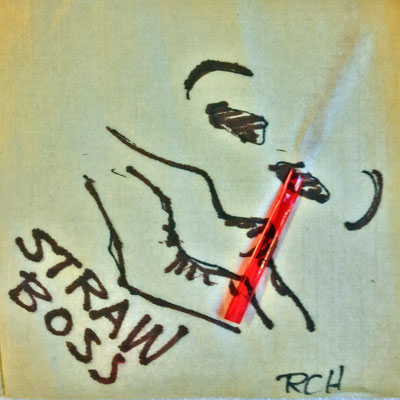
Sea Gull Cellar Bar Napkin Art, Roy Hoggard artist
Parrot
(Restaurant Poem)
Parrot in a halter
Top the restaurant rooting parlor
Picks and promenades
Before the waiter
Waiting, watching
Automatic pump
Pot, pan, plate
Intravenous pyrogenic pulsing,
Pounding, energetic
Stomach filling shake
Halter freeing
Being not afraid to take
Falter
Feel, peel
Understand the meaning of a meal.
Upon the bird
A word
Unlike a bird
Heard from out the body
Of a parrot prodding
Meal
Upon the wheel
An engine turning,
Churning, burning
Choke
Comes the smoke
Squeal.
Upon the table
Parrot babble,
Dabble, dawdle,
Dit.
Friends, employees and even a few customers helped me through this first crisis in my new life. Then, like the hydra with many heads that fought Hercules, a new crisis appeared. As I walked over the Persian carpet in the muted lighting of the Cellar Bar, a frightening thought arose out of the dust—how to make a drink, how to serve it, and how to deal with the eclectic group that frequented the Sea Gull Cellar Bar.
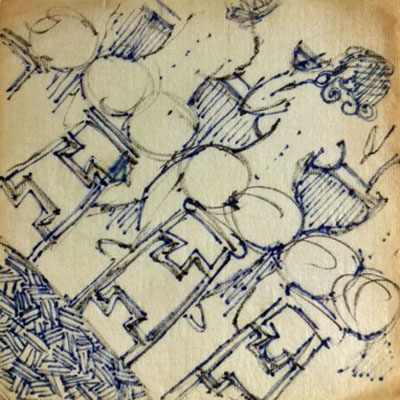
Sea Gull Cellar Bar Napkin Art, artist unknown
In that time before time, when the Sea Gull Cellar Bar really was in the cellar, a lot of Mendocino was imagined, shaped, prodded and produced by those who frequented the place – locals and otherwise. It was a strange den down there, wooden benches covered with oriental rugs cut to fit, brass tables that looked like gongs, overstuffed chairs, a very low ceiling, and crystals dangling from fancy fixtures (everyone thought they were amber until I washed them one night and discovered they were really clear glass deeply coated in nicotine brown!). The eclectic décor fit the clientele, or maybe the other way around, but it worked anyway, and most people seemed really happy with the inherent intimacy of the close seating and subdued lighting. I don’t remember any real “bummers” happening there – people generally took their disagreements elsewhere. Bob Avery, bartender (The Sea Gull Saga Part I)
To this point I’d been only on one side of a bar. The vantage point from the other side is daunting. After the initial shock wears off, it can also be hilarious, sad, and frustrating sometimes all at once. Drinkers often find they have to choose between love, life and the bottle. Happy hour is an opportunity to do some focused research moderated by an unlicensed therapist, the bartender, where drinkers can get the information they need to make an informed decision all at a discounted price. And, it’s fun. The key to a successful happy hour is that the bartender/therapist/gatekeeper must stay in control without appearing overbearing. It helps if the drinkers are, most of the time, mellow.
Brautigan didn’t like the Robin. His favorite joint in town was the Eagles, housed in the FOE Lodge far down Main Street at the eastern end of Bozeman. The polar opposite of the Robin in every way, including location, the Eagles was a workingman’s bar, inexpensive and rough around the edges. George Dickel sold for fifty cents a shot during happy hour. Dave Schrieber was the manager, working both the day and night shifts according to his schedule. When he tended bar, Schrieber was known for his generous pour. Greg Keeler had introduced Richard to the Eagles. They met for burgers (no drinks) at lunchtime before Brautigan’s class. After school got out, it was party time. (Jubilee Hitchiker, The Life & Times of Richard Brautigan, William Hjortsberg)
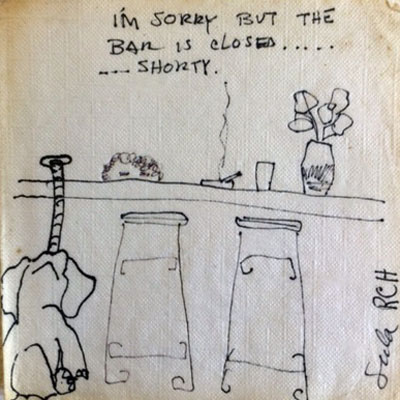
Sea Gull Cellar Bar Napkin Art, artists Sula and Roy Hoggard
Because during the happy hour days of the Cellar Bar, it was kind of fun, kind of crazy, total mayhem. There was certainly a group of people who would come in just for that, which did test your skills a little bit, as far as, A: keeping up with them, and B: making sure that, “Okay, that’s enough.” You kind of ended up babysitting these people sometimes.
In those days, I don’t know if it paid to have help, or didn’t pay to have help but, it got a little crazy at times as far as trying to keep up with the orders. But the main thing was, it was okay, everyone was pretty cool about it. It wasn’t a beer and bloody nose mentality. It was good. (Dick Barham, The Sea Gull Saga Part I)
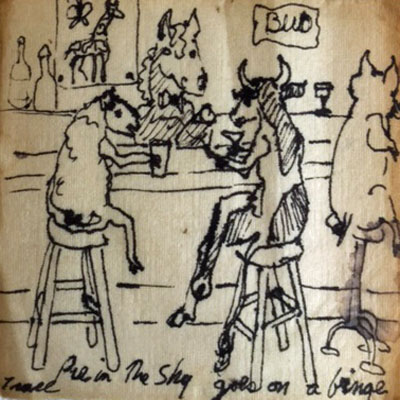
Sea Gull Cellar Bar Napkin Art, artist unknown
When I first entered the Sea Gull scene, there was no happy hour. In fact, happy hour, as we know it today with cheap booze and snacks, originated when I was coming of age in the sixties. According to The History of Happy Hour, this drinkers’ delight originated during the 19th century as R&R for sailors out at sea. The happy hour then was as much about entertainment (boxing and wrestling matches, dancing and movies) as about booze. Later during Prohibition (the 18th amendment went into effect in 1920), people thwarted the law by patronizing speakeasy clubs where they participated in drinking sessions (“happy hours”) before going to dinner in public restaurants where alcohol could not legally be served.
In 1928, Chumley quietly transitioned his radical clubhouse into a literary speakeasy. Edna St. Vincent Millay, a neighbor and occasional bartender at Chumley’s, was one of the earliest regulars, and she soon attracted other Lost Generation writers like John Steinbeck and John Dos Passos. (There are rumors of F. Scott Fitzgerald having sex in a booth and Hemingway sleeping off his hangovers upstairs, but sadly little evidence to back them up.) Whenever an esteemed patron published a book, Lee Chumley would ask for a copy of the dust jacket and encase it in glass along the wall—a tradition that lived on throughout the century.
Literature, Murder & Prohibition: A History Of Legendary West Village Speakeasy Chumley’s
As an interesting aside, I came across this in the Chumley’s article, an explanation of where the term 86’d came from:
Lee Chumley’s most enduring contribution, however, had nothing to do with books. According to The History and Stories of the Best Bars of New York, police would give Chumley advanced notice before a raid, “telling the bartender to ’86’ his customers, meaning they should scram out the 86 Bedford door, while the police would come to the Pamela Court entrance.” The details of this arrangement vary—a different book on the city’s bar history claims cops entered through the Bedford entrance—but most accounts agree that the term “eighty-six it,” still widely used in the hospitality industry, was coined at Chumley’s.
I know something about 86ing bar customers and I wrote about that HERE: 86’d
The federal government eventually figured out that prohibition was too costly to police and more importantly that it resulted in billions of dollars in lost tax revenues. Prohibition ended with the 21st amendment in 1933. A generation later, in the mid-sixties, many restaurants started promoting happy hours where drinks were discounted to build business in the off-hours. The halcyon days of the happy hour coincided, luckily or not, with my tenure at the Sea Gull in the seventies and eighties. By the mid-eighties, concerns about drunk driving took center stage and happy hours were frowned upon. The “Friends Don’t Let Friends Drive Drunk” campaign started in 1983. Happy hours underwent magical surgical procedures that kept them alive. The popular Cheers TV sitcom debuted in 1982 and managed to run for a decade. An emphasis on responsible drinking (an oxymoron?) led to design changes. Cheap drinks were combined with more substantial food choices to keep the lushes from going over the line. More recently, companies like Uber were started to keep drunks out of the driver’s seat. An even more amazing technological innovation in this insular world of computer apps was developed to keep drinkers in their own houses. Cocktail Courier delivers the recipes and ingredients to make your own happy hour drinks at home in the same way that Blue Apron delivers meals. But, this was long after the Sea Gull.
A couple of men at the bar eyed his shirt and tie. Confronted with the bartender, he felt impelled to explain his presence. “Just thought I’d stop by,” he told Jackie G. “Just thought I’d have one. Saw the light. The snow . . .” He chuckled expansively.
“Good move,” the bartender said.
“Scotch?” “Double,” Elliot said. When he shoved two dollars forward along the bar, Jackie G. pushed one of the bills back to him. “Happy hour, babe.” “Ah,” Elliot said. He watched Jackie pour the double. “Not a moment too soon.” (Helping, Robert Stone)
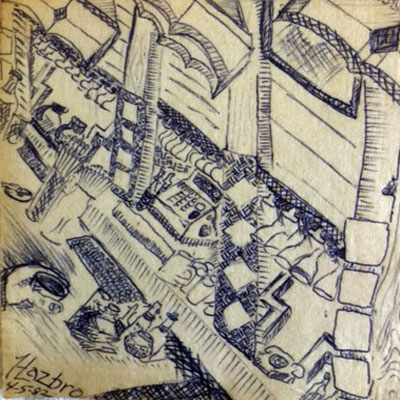
Sea Gull Cellar Bar Napkin Art, artist unknown
Happy Hour was a bartender’s nightmare, and a customer’s delight. Each day, teams of people would meet at the Sea Gull after work to have a drink and socialize. When I was working, I was often overwhelmed by crowds of people, often three or four people deep, all shouting my name and expecting me to remember what they were drinking. When I was meeting my friends there, I was always delighted with the hubbub. I liked knowing that there was somewhere I could go where I would know most of the people in the place. Lee Larsen-White (The Sea Gull Saga Part I)
When I want to remind myself how old I really am, I think about the ways happy hour has changed since those days in the Sea Gull Cellar. How naïve, how unsophisticated we were. Not that all the usual vices weren’t in abundance. After all, sex, drugs, and rock & roll date from the sixties and seventies. We had our share of party girls who offered tricks for a few drinks. We had our vomitoriums in the corners, and fights, we sometimes had those too. The happy hour crowd gathers today for many of the same reasons they did back then.
It was kind of my idea (Happy Hour and the infamous Dirty Bird drink), I talked to Dave, I said, “Hey, lets have a Happy Hour here.” Not that we’re going to encourage putting people into a state of obliteration, but it might be good for business. I can’t remember the circumstances, but we came up with some kind of concoction made of vodka, tequila, Kahlua and half and half in a blender strained in an eight ounce glass for a buck-fifty. So, we used to make as many cans of those as we could—this was on Sundays—for one particular group. When the heads of the wild animals started being removed from the walls we kind of said, “okay, last call.” Time to put that one to rest. (Dick Barham)
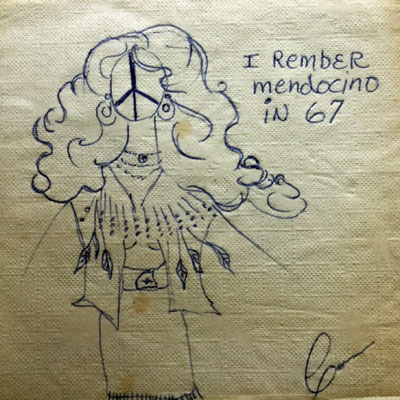
Sea Gull Cellar Bar Napkin Art, artist unknown
Cheap booze is still an attraction but not the only one. With or without online dating services (see Happy Hour Stories by Chelsea Ashe, not a TITM favorite but descriptive enough for today’s younger happy hour crowd), showing up for happy hour is one way of getting to know your possible companion for the night. Others just want to kick back after work or socialize with friends. There is added value in people watching, evesdropping on conversations, and picking up on the local gossip. Happy hour is a cure for boredom and provides something to do for those who have nothing else. Back in those days, the Cellar Bar was “where the action was” as are many present day hangouts.
A favorite TITM fictional rendition of an odd but typical happy hour was penned by David Wallace in Chapter 46 of his unfinished novel, The Pale King. The chapter begins as follows:
What usually happens is that on Friday afternoons a percentage of Pod C’s revenue officers meet for Happy Hour cocktails at Meibeyer’s. (The Pale King)
Things progress from there. The chapter winds on through several pages including a marathon session where one of the characters (Meredith Rand) confesses her psychological deformities in vivid detail to an almost nonhuman fellow accountant (Shane Drinion). Tedious yes, but wonderfully typical happy hour conversation that any aficionado of happy hours would recognize. The chapter’s protagonist, Meredith Rand, realizes she is going on and on, but she can’t help herself.
It has suddenly occurred to Meredith Rand that Sane Drinion might be one of those ingratiating but ultimately shallow people who could seem to be paying attention while in fact allowing their attention to wander hill and dale all over the place, including possibly to considering how he wouldn’t be sitting here nodding politely and listening to this incredibly boring dribble, narcissistic dribble, if it didn’t afford him a chance to look directly at Meredith’s bottomless green eyes and exquisite bone structure, plus a bit of visible cleavage, since she’d taken off her flounce and unbuttoned her top button the minute the 5:00 buzzer had sounded. (The Pale King)
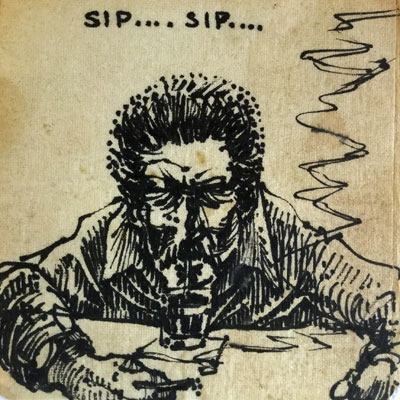
Sea Gull Cellar Bar Napkin Art, artist unknown
People love happy hour, especially in small towns where it becomes a hub of local activity. It’s the perfect time to socialize with colleagues or friends, have a couple of drinks, some bites and good conversation. Sex is in the air. An element of surprise adds suspense. And, who knows where things might be headed?
The Lion
(Happy Hour Poem)
The Lion waits outside the door
Enticed by the smell of fresh meat
Within, the brothel whore
Prepares the substance of her treat.
Green eyes smiling
Lion claws the lock
Opening, beguiling
Answering the knock.
We see them meet.
She rips the mane from his throat.
Tears at his skin.
Sucks the dark blood
Through nostrils thin
But protrudent.
Later
When she drags him by his leg
Toward her lair
To be consumed at her leisure
The thought occurs to the Lion
That he is once again
Vulnerable.
Some go so far as to consider happy hour snacks dinner. These regulars come to eat and to drink. Any time you have a drink in your hand it’s happy hour, but it’s even happier when that drink is cheap, you’ve got dinner on the side, and you don’t have to do the dishes. We sold a lot of Dirty Birds but also Metaxa brandy, Kamikazes and Long Island Iced Tea.
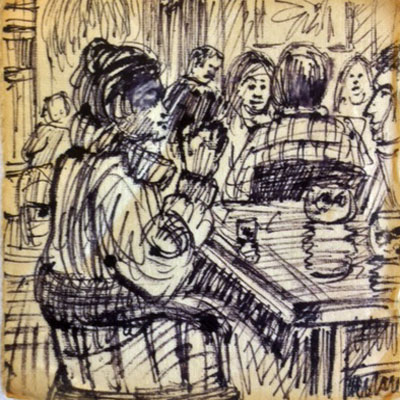
Sea Gull Cellar Bar Napkin Art, artist unknown
From my perch behind the bar I watched romances bloom and fade. They’d meet, seduce each other, become a couple. Then they’d argue, flirt with others have a fight, split up. The entire process frequently took less than a week. For some reason Metaxa brandy was the thing. We served more Metaxa than anywhere in the world outside of Greece. Coffee drinks were popular, too. Lots of Kahlua, lots of cream, very sweet and hot. Irish coffees cured a lot of flu attacks. We often had a room full of wide-awake drunks. (Tony Miksak, The Sea Gull Saga Part I)
Drinks have changed a lot but many of the old drinks are making a comeback. The craze for certain drinks dates back at least to the 19th century when absinthe became the muse of writers and poets:
The spirit was a muse extraordinaire from 1859, when Édouard Manet’s The Absinthe Drinker shocked the annual Salon de Paris, to 1914, when Pablo Picasso created his painted bronze sculpture, The Glass of Absinthe. During the Belle Époque, the Green Fairy – nicknamed after its distinctive colour – was the drink of choice for so many writers and artists in Paris that five o’clock was known as the Green Hour, a happy hour when cafes filled with drinkers sitting with glasses of the verdant liquor. (Absinthe: How the Green Fairy Became Literature’s Drink)
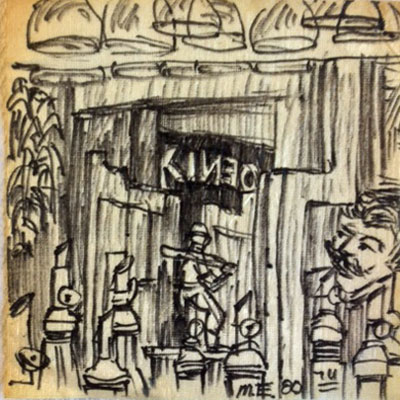
Sea Gull Cellar Bar Napkin Art, Mike Evans artist
A good bar is a place where you can get a little mercy, where commerce doesn’t interfere with human considerations. The Cellar was such a place for me. Amid the rush for the tourist designed jiggery—pokery, the Cellar had risen above contrivance. All the junk in there was real junk, and if the place was seen in the harsh light of day, the place was absolutely grotty. Cobwebs, nicotine stains on the walls, the awful blowfish lamp which I plotted against daily, the dried alligator skin, the happy pictures of Cinderella’s Ball, fifty-seven of the most uncomfortable seats in Christindom, the beautiful rugs, the lamps, all these things placed somewhere else would have made no sense. But in the Cellar they made complete sense …
This is a small town, with a small town bar. People talked about what they cared about. Here questions like, “do you know of a place to live”? or “your place, my place, or forget it”? were just as important as any talk of art. For this was a place where people came to ease their loneliness. Every time the cowbells on the door signaled, someone arrived with expectations, and sometimes one left with disappointment. Such is the way of the world. (Bill Bradd, Sea Gull Cellar Bar Remembered)
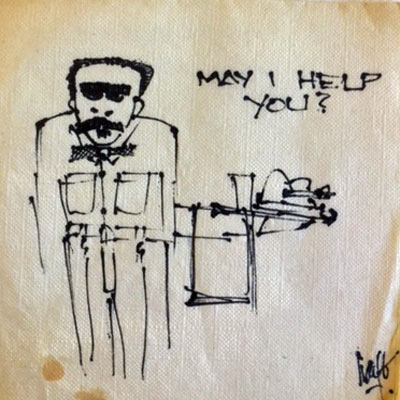
Sea Gull Cellar Bar Napkin Art, Jack Haye artist
Still, it’s not all fun and games, is it? What goes on inside the heads of all those folks pulsing with the happy hour music, drink in hand, faces pleasant but expressionless? It’s possible they themselves don’t know. Like the Southern women in Always Happy Hour Stories by Mary Miller, many happy hour drinkers are seeking more than cocktails, honky-tonk music, and sex on demand but they aren’t sure what “more” is.
In the original Sea Gull Cellar we didn’t clean the bar until the afternoon of the next day. That’s how the fire in 1976 that burned the place to the ground was able to progress unseen. I often did the vacuuming, sucking up the Japanese rice crackers and fried green peas, straightening the Persian rugs, fluffing out the soft stuffed pillows, wiping the last night’s unidentifiable grime off the tables, and setting out clean ashtrays. In those days it was cool to smoke in bars.
At Work on Tuesday Morning
(Cleaning Bar Poem)
Haven’t made it.
Worked in a grocery store when I was young.
Up at five thirty to unload the freight.
Donuts and coffee when I was done
And sawdust on the floor with pieces of animals in it.
Haven’t made it yet.
Went to school when I was older
Close to San Francisco Bay.
Learned a lot about myself then
Almost made it in a way.
Bought a business when I finished.
Had some money from my dad.
Don’t think I’ll ever make it.
Still, I’m sorta glad
About it.
Had a son once.
Don’t see him much.
Love him still.
Vacuum vacuum vacuum vacuum
Vacuum the dirt away.
For the staff, happy hour was hard work. For one thing, the old Cellar Bar was not well organized. The refrigerator was at the opposite end of the room from the bar “hidden” under a spiral staircase. Beer, wine, cherries, onions, olives, limes, lemons, half & half, whipped cream and more had to be fetched from the frig and carried to the bar. The ice machine was outside in the back. There was no refrigeration under the bar itself and everything was kept cold in rubber bus tubs filled with ice that tended to leak onto the cement flow making a small river out of the area where the bartender worked bridged by squishy rubber mats.
Cleaning behind the bar was a constant chore—glasses, thermoses, sinks, bar mats, top bar, back bar, shelves, bottles—on and on. Fruit flies were a problem and the trash, which accumulated quickly, had to be carried upstairs.
After cleaning and stocking, I usually opened the bar to greet the first customers as they arrived. By the time the night bartender showed up, happy hour was in full swing. I was guilty, as accused, of sometimes putting on raucous music like Jimmy Buffett’s Let’s Get Drunk (and Screw) to ramp up the crowd and get things moving. It was my way of paying back Dick Barham who followed me and who had suggested the happy hour idea in the first place.
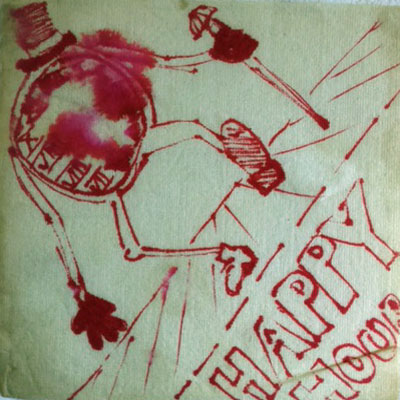
Sea Gull Cellar Bar Napkin Art, artist unknown
‘You don’t exactly party down, do you?’ ‘I get full quickly. My stomach doesn’t seem to hold very much.’ (David Wallace, The Pale King)
Some people came in for happy hour simply because it was a tradition, a habit, something to do after work or before dinner. Unlike the city where one bar might attract stockbrokers and bankers and another one working stiffs, the Sea Gull was a true melting pot of school teachers, carpenters, musicians, professionals, would be writers and poets, and hangers on of all sorts including the famous and the nonfamous. Some came just to watch, some for cheap thrills, and others to brag about their skills and flaunt whatever charms they thought they had.
Different levels and Pods tend to congregate at different places, some of which are downtown and ape in various ways the more stylized venues of Chicago and St. Louis. The Bell Shaped Men can be found nearly every evening at Father’s, which is right there on Self-Storage Parkway and owned outright by the area’s Budweiser distributor; its function is less social than intubatory. Many of the wigglers, on the other hand, frequent the steroidal college bars around PCB and Bradley. Homosexuals have the Wet Spot in the downtown arts district. Most of the examiners with children, of course, go home to spend time with their family, although Steve and Tina Geach are often at Meibeyer’s together for Friday’s 2-H. Nearly everyone finds it necessary to blow off some of the unvented steam that’s accreted during a week of extreme tedium and concentration, or extreme volume and stress, or both. (David Wallace, The Pale King)
The truly famous valued the anonymity that a small town bar could provide. Like Gene Clark of The Byrds who frequented the old Sea Gull Cellar Bar. He was friends with Philip and Ea O’Leno of Albion and bought property next to them. Philip built much of the bar and furniture for the new bar constructed after the fire.
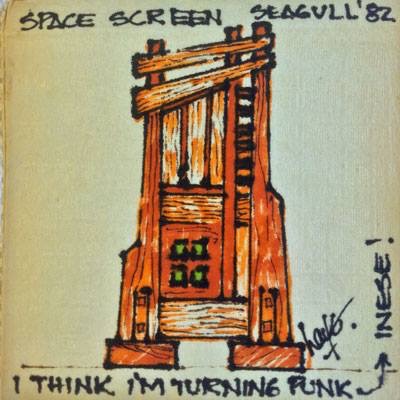
Sea Gull Cellar Bar Napkin Art, Philip O’Leno Room Divider, Jack Haye artist
Gene ventured into the Seagull Cellar Bar in the town of Mendocino, where he befriended proprietor-bartender Martin Hall. Gene became a frequent visitor to the Seagull and to his delight was treated no differently than any of the other locals or passersby. No one knew he was Gene Clark of the Byrds. Martin informed Gene that he had a cabin for rent across from the Andiron Lodge in Little River. Gene soon rented the cabin and, inspired by his rustic surroundings, roundings, begin writing a body of songs that represented a more basic approach to his muse-just just acoustic guitar and voice. (Mr. Tambourine Man, John Einarson)
Keeping up with drink orders, drunks, and the general chaos could cause overload unless you were a strong Type-A personality. Flexibility was a must for a bartender who had to mediate between hippies and rednecks, tourists and locals, strangers and friends. You needed to be a good story teller and a good listener and know when to focus on one or the other.
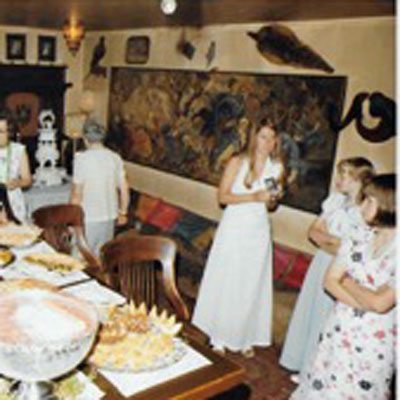
Old Sea Gull Cellar Bar, private photo
Mike Evans: Is there any one thing that stands out from those days, more than anything else? (The Sea Gull Saga Part I)
Dick Barham: I don’t know. That’s a tough one. I think, as you ask the question, the thing that comes to mind was that it was the kind of job you looked forward to because there was always something unexpected that was going to happen. When the door opened, you could hear the reindeer bells, and you couldn’t see who was coming in.
I think what was kind of neat, is that, yeah, it was a job, but it was certainly an experience. People would come in and be a little bit different, then be a lot different when they left, so you discover things about them, and of course, it is true, that you become a really good listener, well, they can confide in you. And they really did. It was amazing, after just the one drink that they came in for, they would really start opening up. I guess it goes with the territory. But aside from that, there were a lot of circumstances. There were funny instances that happened all the time, every night something funny would happen. A couple of times there were some very scary instances as well. But once again that goes with the territory when you’re dealing with alcoholism, which is the real downside of it, because if people don’t know when to quit, you have to assume that role. As far as the instances, we don’t have enough time. I could go on and on. (
Closing up could be one of those “instances.” What to do with drunks who’d been there all night and were now passed out in a corner? There were no hard and fast rules but they were not allowed to sleep it off inside the bar. Carefully and with the full respect and consideration they deserved, out the front door they were escorted or carried as need be and left to fend for themselves on the stairs leading down to the Cellar.
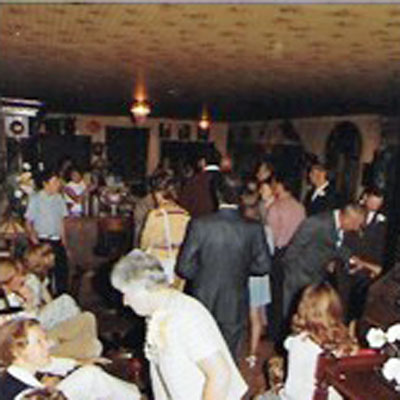
Old Sea Gull Cellar Bar, private photo
They fixed him on one of the three chairs between two women who kept constantly filling his glass. He drank; he laughed; he talked; he sang, too. He tried to waltz with his chair, and fell on the ground. From that moment, he forgot everything. It seemed to him, however, that they undressed him, put him to bed, and that his stomach got sick. When he awoke, it was broad daylight, and he lay stretched with his feet against a cupboard, in a strange bed. (A Queer Night in Paris, Guy de Maupassant)
The Sea Gull Cellar was a rural scene—no disco, no bell bottoms, informal to the nth degree. It was around during Vietnam, Nixon, Carter, stagflation, the Iran hostage crisis, and communes. Life was slower then (as old folks always say), and Mendocino was off the radar, too far out of The City (San Francisco) to matter much except to those hardy souls who made the long, windy drive north. Some ultimately stayed. The locals, those who preceded the Sea Gull days, were independent types—fishermen and loggers mostly, who viewed the newcomers with suspicion but generally learned how to get along with them. The tourists who came, first in small numbers and later in large crowds, appreciated watching it all.
Weed soon found he’d been 86’ d from every tux outlet in Hollywood and on south, so he headed the other way, up over the passes and out the long desert arterials, out past the seed and feed houses and country music bars and Mexican joints with Happy Hours featuring 99 ¢ margaritas out of a hose, under the smog, the dribbling rain, the toxic lens of sky, to where folks, he hoped, were more trusting if less picky about what they wore, and where in fact formal dress, by some subterranean fashion law, turned out to be much less conventional. There were free though small-sized eats for everyone, such as mini-enchiladas and shrimp teriyaki, and well drinks at happy-hour prices. (Vineland, Thomas Pynchon)
Marlene McIntyre (The Sea Saga Part I)
Everybody got drunk there. I remember when the Dirty Bird first came in. Tony Miksak made it, and I was not much of a drinker, they were trying out these Dirty Birds, and so he made it, and I tell you what, I could not get off of that stool, I thought, “Good God, how am I going to get home?”
Actually, I don’t think it mattered that the (new) people came, I think it (Mendocino) changed because those of us that were here, we changed too. I wasn’t any longer what I thought I was always going to be, just a mom and a wife. I wasn’t becoming that any more.
I never had any problems with anybody. I’d just say, “You guys gotta leave, and it’s time to go right now.” I remember Philip O’Leno, he was drinking, he intimidated everybody, but all he would do was just get up and go out the door, maybe mumble, but he’d leave.
Whenever someone would be acting rowdy in the bar, and they needed to be escorted out, I’d go up there and I’d say “You guys, you gotta leave.” And I always knew there were guys up there like Danielle and Billy Watson and all those guys, they were gonna stand up for me. Nobody would ever dare to say a word to me, because those guys would have been all over them. Even though I had asked them to leave, too, at some time or another. And they went.
So, why exactly do you call it happy hour? Why did I pull myself out of one life and insert myself into another so very different? Actually, I don’t really know. I might have made other choices. Fame and fortune were never the goals I sought. If you can find one true friend in life, that is enough to extend the miracle. I found many. The restaurant business is addictive and all consuming. There came a time when I had to step away. It feels good to look back at the good times. Many of those times are associated with a happy hour either in the old Cellar downstairs or in the new one up above the restaurant. Alas, it’s all gone now, but it was there once. There are new happy hours in different places, and now I am back on the other side of the bar on the outside looking in. And, at my age, that’s okay. There are coffee shops and they are good places to read and write and socialize too.
There are pubs, of course, but we can’t always be drinking. (Lanark: A Life in Four Books, Alasdair Gray)

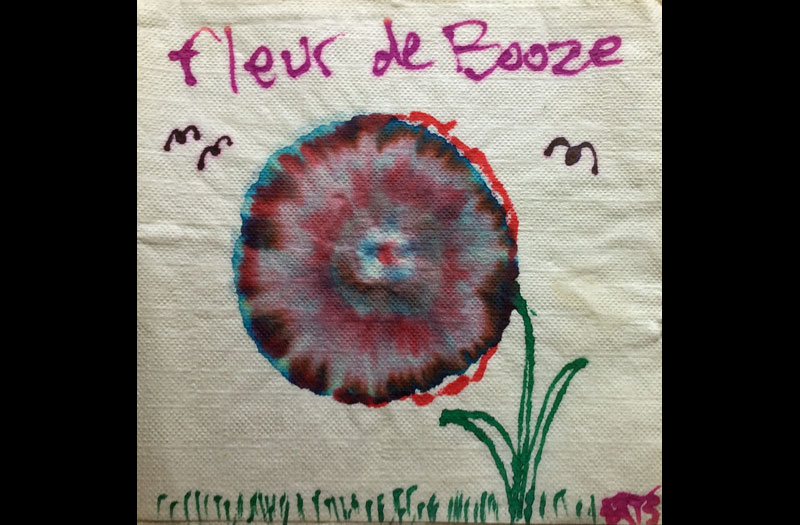
All I can say is WOW! Again…I think my life here on earth would have been more enriched had I spent somme time at the Seagull…..
Thanks Dave…
Mendocino String Quartet.
Tony, cellist, still, and Bartender, then.
Drinks after rehearsals and performances at…oh, duh…
And unofficial office hours after Big River court sessions.
Great article. Thanks.
David,
This article captures the old Sea Gull Cellar bar that I experienced as a bartender for a year in 1971/72.
Terry Johnson
And you were the first to create a drink book that we all used, the little black book of Terry. I wish I could find it. I’ve looked through all my boxes of memorabilia and so far come up short. I do remember the Liver Destroyer (Wild Turkey and chartreuse) that I think you may have invented. Thanks !
I also made a drink called the Fog Cutter from a Trader Vic bar book.